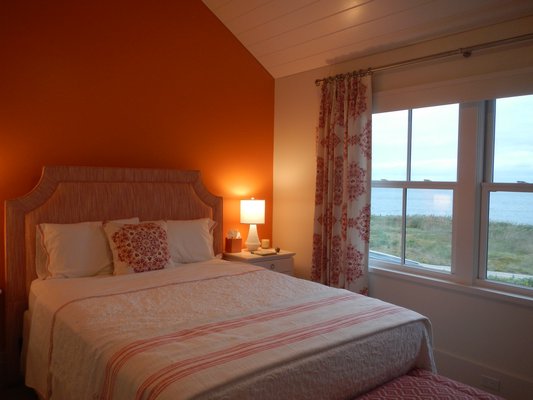
A new energy-efficient home has been completed in East Quogue, replacing another that had been a casualty of two devastating storms.
After her Sunset Avenue home sustained extensive damage from hurricane Irene in 2011 and Superstorm Sandy in 2012, rendering it uninhabitable, Kim Erle decided to tear it down and start over. This time, the house would not only be ready for the next big storm, it would be environmentally sustainable, too.
Ms. Erle is a Leadership In Energy and Environmental Design-certified project planner who made sure her new home was a model example of LEED-thinking.
LEED certification is a program designed and run by the United States Green Building Council, a coalition of developers from architects to general contractors that specializes in sustainable building practices.
Energy efficiency is one of the goals of LEED certification, but the standard also takes into account the quality of life of the occupant, sustainability and ability to recycle used building materials. Points are awarded for check items such as natural light and air quality, as well as carbon footprint-reducing utilities and materials.
Last week, Ms. Erle unveiled the fruits of her labor, allowing guests to tour her new 3,600-square-foot, five-bedroom, 6.5-bath abode equipped with a pool and pool house.
“We removed 100 percent of the house, but of the materials that came out of that house, 90 percent of them were able to be diverted, which means it’s kept out of the landfill,” Ms. Erle explained. Materials that were reusable, such as the windows, were sent to Habitat for Humanity and its ReStores, which will resell them. “The goal was to remove the structure in an environmentally conscious way,” Ms. Erle said.
Watching how many materials can be repurposed through this careful dismantling can be eye-opening. “When you see that process, it’s hard to justify traditional demolition,” said Kathryn Cannon, a LEED-accredited professional who consulted on the project. “It doesn’t take that much to do it the right way.”
Approaching the rebuild, Ms. Erle had a few critical objectives she wanted to achieve—the house being as storm-resistant as possible was top among them. That’s why she made sure each windowpane was made of impact-resistant glass. “They basically shoot a missile at these things at 120 miles an hour and the glass doesn’t shatter,” she said. Keeping the building impenetrable will prevent wind from getting in and potentially blowing the roof off during a storm.
Equally as important was setting the house on pilings, 130 to be exact. Flood waters can come and go without affecting the home or its foundation.
With these items in place, Ms. Erle set her eyes on all things sustainable. Wherever possible, she used environmentally friendly materials and technology. For example, the living room, with its southeast-facing windows, can be “hotter than Hades” with its abundant sun exposure. In an effort to reduce use of the air-conditioning system, she had solar shades installed and linked to the home automation system. “So, in the morning our shades are down and preventing that sunlight from heating up the room, and you can still see through them,” she said. The shades have 10-percent visibility.
There are also energy-efficient ceiling fans and a wood-burning fireplace that releases low emissions, as well as a filtration system that brings in fresh air while expelling stale air through different outlets.
Ms. Erle made sure most of her furniture was upholstered in indoor/outdoor fabrics, which has a longer lifespan and will not fade. And all of the floor coverings are 100-percent wool or cotton, thus eliminating the toxic polypropylene backing on traditional rugs.
In addition, every light in the home, except for the dining room chandelier, is LED-fitted, and every room was painted with paint that has zero VOCs, or volatile organic compounds, which can release toxic emissions.
Ms. Erle also installed a few high-tech gadgets with the same environmentally-friendly mission in mind. An induction stove, for example, has a flame that will follow a pot around as it’s moved to different burners. “It only heats the pot and what’s in it,” she said. “It doesn’t heat the air around the pot.”
Ms. Erle dubbed her enterprise the Sunset Green Home Project, and extensively documented her experience on a blog. She is seeking LEED Platinum certification for her home. LEED homes are rated as silver, gold and platinum and the tax credit is dependent on that rating. If she achieves this rating, Ms. Erle will save about $15,000 over the next 10 years in property taxes.
“It’s feeling finished, so it’s really great. It’s been a really long journey and a very tiring journey,” said Ms. Erle, who started the project three years ago. “But it’s really good to know that we can use it the way we anticipated using it and that it really does meet our needs.”